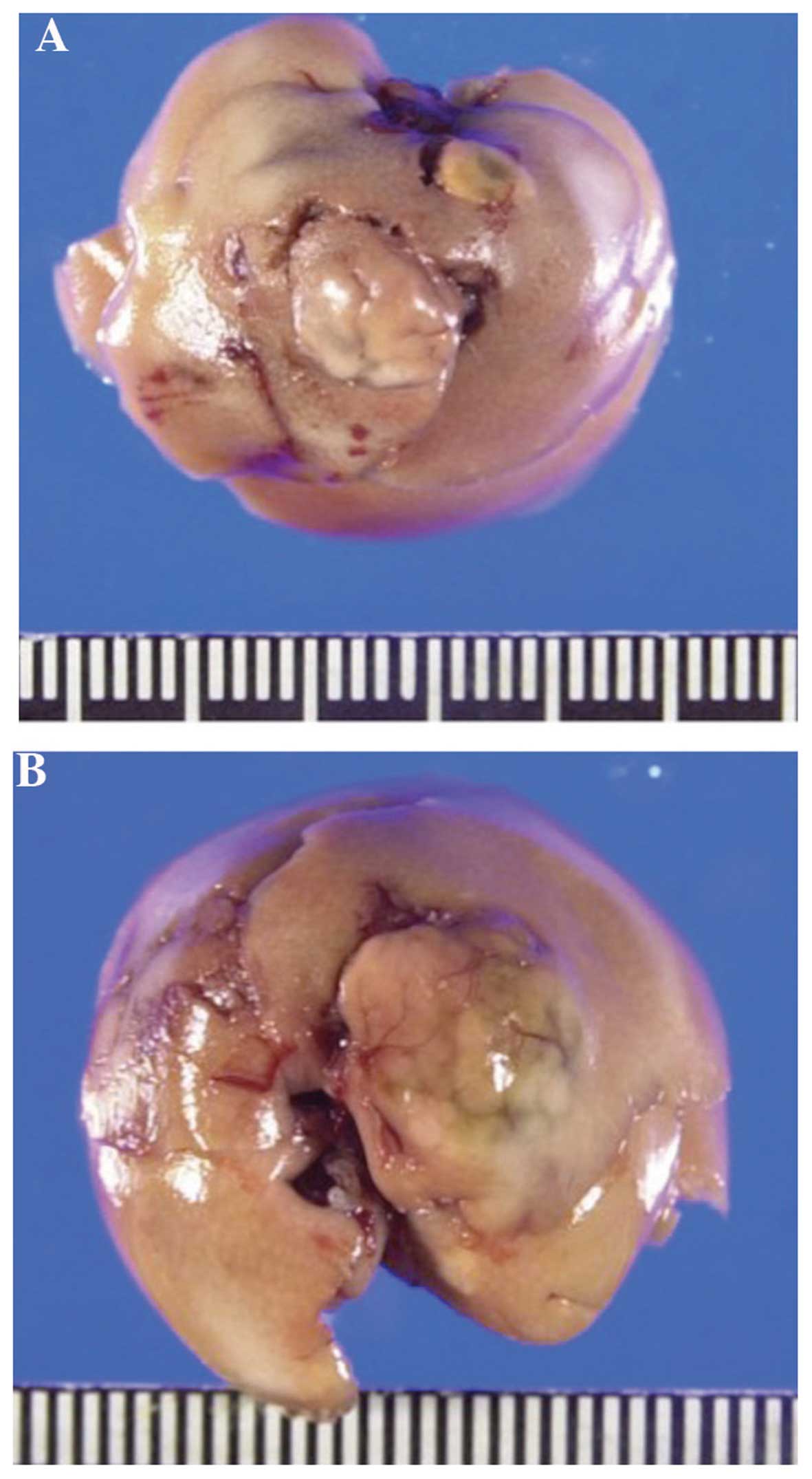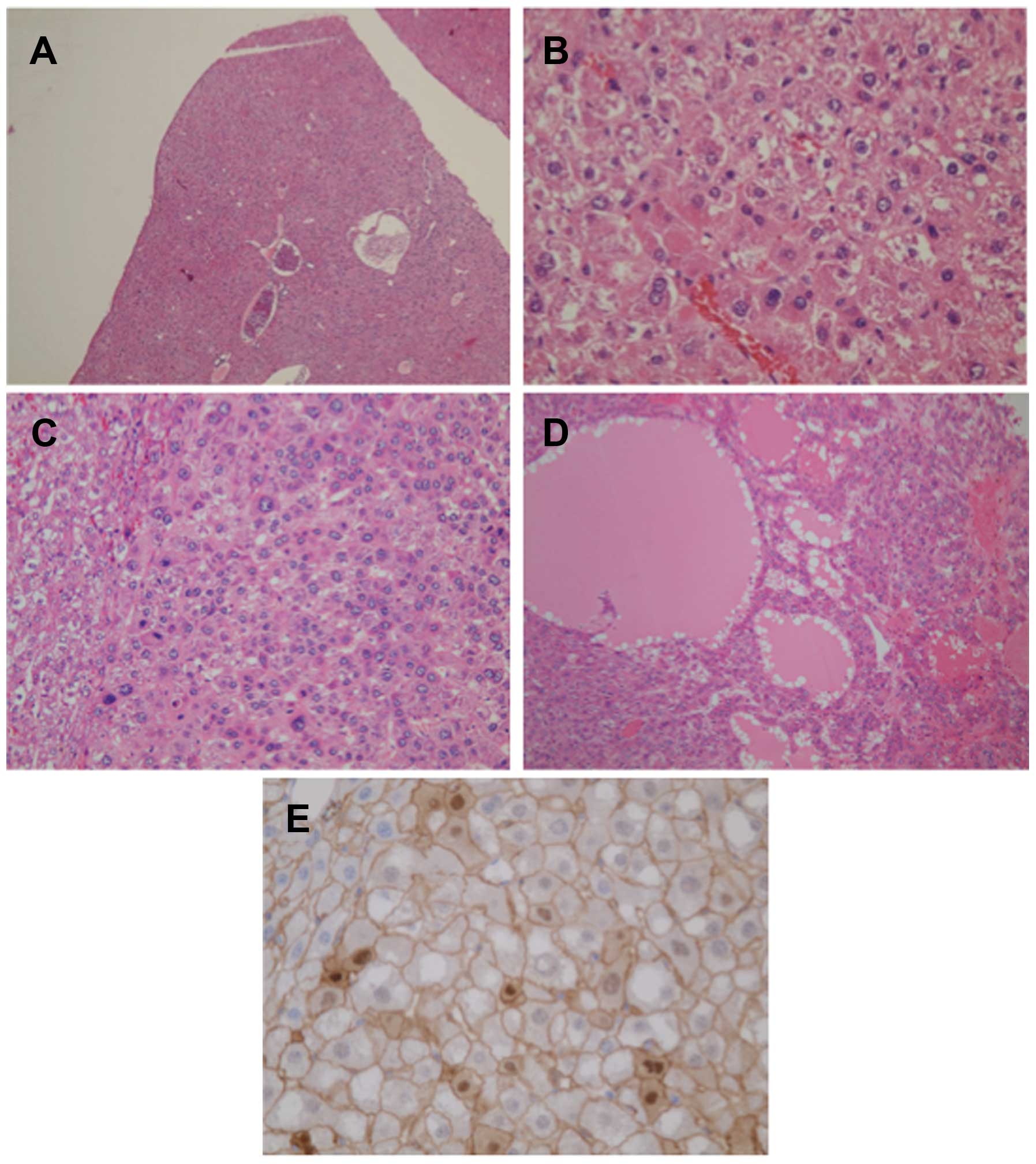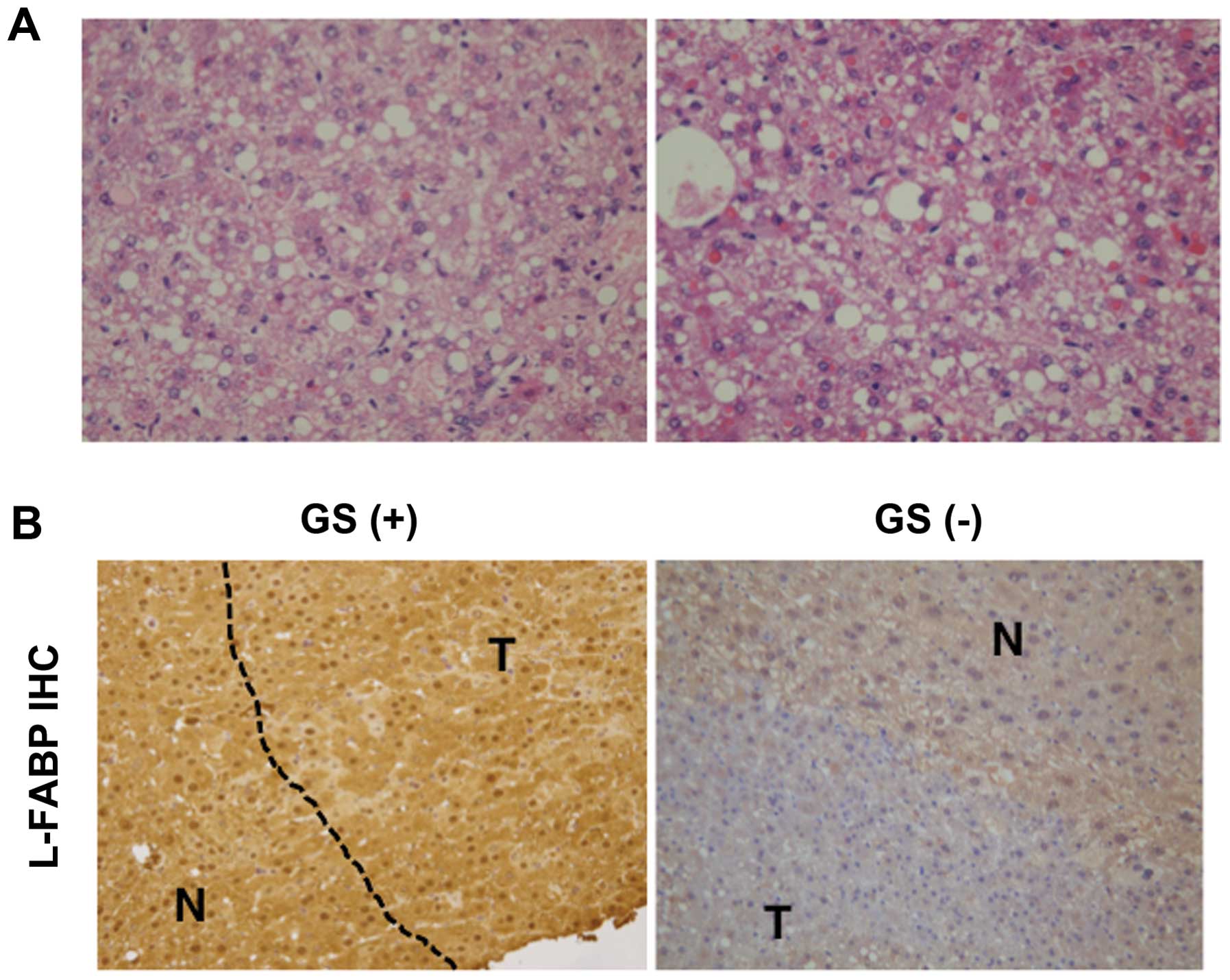Histopathological characteristics of glutamine synthetase-positive hepatic tumor lesions in a mouse model of spontaneous metabolic syndrome (TSOD mouse)
- Authors:
- Published online on: June 9, 2016 https://doi.org/10.3892/mco.2016.924
- Pages: 267-270
-
Copyright: © Takahashi et al. This is an open access article distributed under the terms of Creative Commons Attribution License.
Abstract
Introduction
Tsumura-Suzuki obese diabetic (TSOD) mice are an inbred ddY strain that displays spontaneous metabolic syndrome and type 2 diabetes mellitus. At the age of ≥8 weeks, this strain develops apparent obesity, glycosuria, hyperglycemia and hyperinsulinemia (1–3). Due to its characteristics, the pathophysiology of TSOD mice is also considered to be reflected in metabolic syndrome, which is a severe risk factor for the development of incurable diseases that affect the entire body. From 4 months of age onwards, the liver of TSOD mice starts to exhibit fatty degeneration, hepatocellular ballooning, Mallory bodies and neutrophil infiltration, which are markers of non-alcoholic fatty liver disease (NAFLD) and subsequent non-alcoholic steatohepatitis (NASH). Furthermore, after 10 months of age, spontaneous hepatic tumors also start to develop in TSOD mice (4).
NAFLD and NASH are associated with metabolic syndrome, obesity, type 2 diabetes and dyslipidemia. NASH is involved in a multistep process that begins with the accumulation of lipids in the liver and additional factors, such as oxidative stress and cytokines (5). It has been reported that NAFLD and NASH may lead to cirrhosis and the development of hepatic tumors, as well as hepatitis B virus (HBV) and hepatitis C virus (HCV) infections (6,7). It is widely believed that the incidence of NAFLD/NASH as a cause of hepatic tumors will increase with the improvement in anti-HBV and anti-HCV strategies over time. Hence, thorough understanding of the pathological sequence from NAFLD/NASH to hepatic tumorigenesis is required.
A variety of diagnostic markers for hepatocellular carcinoma (HCC) have been recently identified. Glutamine synthetase (GS) is one of the markers involved in nitrogen homeostasis in the liver (8–10). GS is a target of Wnt/β-catenin signaling, which is activated in HCC, and accounts for the association between GS expression and the growth of HCC (11,12). We previously reported that GS-positive lesions were also found in tumors in TSOD mice (4); however, the detailed characteristics of GS-positive and -negative tumors in TSOD mice have not yet been elucidated. The aim of this study was to clarify the histopathological characteristics of hepatic tumors derived from TSOD mice in GS-positive and -negative legions.
Materials and methods
TSOD mice
A total of 40 7-week old male TSOD mice were purchased from the Institute for Animal Reproduction (Kasumigaura, Ibaraki, Japan). All the mice already exhibited obesity at 7 weeks of age (>40 g), eventually reaching a weight of >55 g. The mice were maintained on an MF basal diet (Oriental Yeast, Tokyo, Japan) and chlorinated water ad libitum, and were housed under specific pathogen-free conditions. This study was performed in accordance with the animal experiment guidelines specified by the University of Toyama. The TSOD mice were sacrificed at 15 months of age with sodium pentobarbital, and their livers were excised for histological analysis. During the autopsies, the macroscopic tumors in the liver were counted and their diameters measured. The excised livers were then fixed in 10% neutral-buffered formalin and embedded in paraffin.
Histopathological and immunohistochemical analysis
All the formalin-fixed, paraffin-embedded tissues were processed, and 4-µm serial sections were cut and stained with hematoxylin and eosin. Immunohistochemical staining for GS, β-catenin and liver fatty acid-binding protein (L-FABP) were also performed. Rabbit polyclonal anti-GS (clone GS-6; dilution 1:500; cat. no. MAB302; Millipore, CA, USA), anti-L-FABP (dilution 1:100; cat. no. ab7366; Abcam, Cambridge, UK) and anti-β-catenin (dilution 1:100; cat. no. GWB-764147; GenWay Biotech, San Diego, CA, USA) were employed as the primary antibodies. The sections were incubated with the primary antibodies in a wet chamber for 60 min at room temperature. After rinsing with Tris-buffered saline (TBS) containing 0.1% Tween (TBS-T), the sections were incubated with EnVision Peroxidase (PO) (Dako, Tokyo, Japan) for 60 min at room temperature. After rinsing in TBS-T, 3,3′-diaminobenzidine (Sigma, Steinheim, Germany) was applied as a substrate for the PO. Using GS-stained slides, the diameters of the GS-positive or -negative tumor lesions were measured.
Statistical analysis
A two-tailed Mann-Whitney U test was employed to compare the mean diameters of the GS-positive and -negative tumor lesions. A P-value of <0.05 was considered to indicate a statistically significant difference.
Results
Macroscopic findings of hepatic tumors in TSOD mice
The macroscopic observations of hepatic tumors in TSOD mice were reported in our previous study (4). Representative pictures of the hepatic tumors are shown in Fig. 1. In this experiment, 92.5% (37/40) of the mice exhibited ≥1 hepatic tumors, with a total of 39 visible tumors. We then measured the macroscopic size of these tumors; the mean diameter ± standard deviation was 5.3±2.8 mm (data not shown).
Characteristics of GS-positive and -negative tumors in TSOD mice
Using all the tumor lesions, we conducted immunohistochemical staining for GS. The majority (28/39; 71.8%) of the tumors expressed GS in a diffuse manner. Tumors with >50% stained cells of any intensity were classified as GS-positive. A typical image of a GS-positive tumor was shown in our previous study (4). The mean diameters of the GS-positive and -negative tumors were 4.55±3.07 mm and 3.59±0.98 mm, respectively; the difference was not statistically significant (Table I).
Table I.Size of glutamine synthetase (GS)-positive and GS-negative liver tumors in Tsumura-Suzuki obese diabetic mice. |
Histologically, small lesions (<1 mm) in GS-positive cases exhibited dysplastic nodules with nuclear atypia (Fig. 2A and B). By contrast, part of the large lesions (>3 mm) of the GS-positive tumors exhibited a thick trabecular pattern (Fig. 2C) and/or a pseudoglandular pattern (Fig. 2D), resembling that of human HCC. When testing GS-positive tumors for β-catenin via immunostaining, translocation of β-catenin into nuclei with enhanced membranous expression was found in a measurable population of tumor cells (Fig. 2E). Regardless of the tumor size, GS-negative tumors exhibited profound fatty change with low nuclear atypia (Fig. 3A). Since this is similar to benign hepatocellular adenoma (HCA), we next performed immunohistochemical staining for L-FABP, a target of hepatocyte nuclear factor (HNF) 1α. The GS-positive tumor lesions expressed L-FABP at levels similar to those in the adjacent normal areas, whereas expression of L-FABP in GS-negative tumors was apparently lower compared with that in adjacent normal areas (Fig. 3B).
Discussion
Several researchers have focused on the pathological process from NAFLD/NASH to hepatic tumorigenesis and the consequences of this process, as elucidating these will enable an understanding of the molecular mechanisms involved and, thus, planning of an effective treatment strategy. Based on their clinical characteristics, the association between NAFLD/NASH and hepatic tumorigenesis has been extensively discussed (13); however, the molecular basis of this correlation has not yet been clearly determined. The use of an appropriate animal model is a potent methodology to enable the molecular analysis of this pathogenetic process. Thus, TSOD mice, which exhibit typical symptoms of the metabolic syndrome-NAFLD/NASH-hepatic tumor sequence, are an ideal model for analyzing the pathological processes from NAFLD/NASH to hepatic tumorigenesis (14). TSOD mice spontaneously develop hepatic tumors at 15 months of age at an extraordinarily high rate compared with other experimental animal models. On average, these tumors are sufficiently large to be detected with a naked eye and, thus, the tumor lesions alone may be isolated for further analysis. This characteristic provides major advantages for biochemical or biomolecular examinations.
To assess whether tumors from TSOD mice exhibit the characteristics of HCC, we performed immunohistochemical staining for GS, which is a diagnostic marker of HCC in humans. Over 70% of the tumors were positive for GS in a diffuse manner. Small lesions in GS-positive cases exhibited dysplastic nodules, which are considered to be the premalignant lesions of liver cancer. In larger GS-positive lesions, thick trabecular and pseudoglandular patterns were identified, partially invading the portal area. The early changes (after 6 months of age) observed in the liver of TSOD mice include hepatocellular ballooning and Mallory-Denk bodies (data not shown). The pathological findings described above are typical of well-differentiated HCC developing in a background of NASH in human patients. These results strongly suggest that GS-positive tumors in TSOD mice histologically reflect HCC in humans. Immunohistochemical staining for β-catenin also demonstrated that activation of Wnt/β-catenin signaling occurred in GS-positive tumors. Wnt/β-catenin signaling is closely associated with malignant transformation and the development of HCC (15,16). Hence, GS-positive tumors in TSOD mice may exhibit dysplastic nodule-carcinoma sequences.
Nearly 30% of the tumors in this study were negative for GS. The majority of the tumors exhibited profound fatty change and low nuclear grade, whereas some tumors were diagnosed as HCA, which is a benign liver neoplasm. As shown in Fig. 2A, GS-negative tumors exhibited macro- and microvesicular steatosis, which are characteristics of human HCA carrying HNF1α inactivations (17). HNF1α is known as a regulator of L-FABP, which is expressed in very high levels in the liver (18,19). Clinically, downregulation of L-FABP, possibly due to the inactivation of HNF1α, is found at very low rates in HCC lesions (20). Immunohistochemical staining for L-FABP revealed that GS-negative tumors were also negative for L-FABP, whereas GS-positive tumors expressed high levels of L-FABP, similar to those in the adjacent normal areas. Moreover, no inflammatory lesions were found in GS-negative tumors (data not shown), which is another method of distinguishing malignancy from HCA. Taken together, the characteristics of GS-negative tumors in TSOD mice indicate that benign liver neoplasms mimic HNF1α-inactivated HCA, rather than HCC.
The results of this study suggest that the TSOD strain is a spontaneous hepatocarcinogenesis model that may be used to monitor the pathophysiological characteristics of the early to the well-differentiated stages of HCC. For HCC to develop, no specific conditions (e.g., gene modification, special diet, or administration of carcinogenic agents) are required. Furthermore, GS-positive tumors in TSOD mice possess characteristics similar to those of well-differentiated HCC in humans. These characteristics may be valuable for medical or pharmaceutical approaches to hepatocarcinogenesis, particularly for the examination of molecular basis and drug effectiveness. However, some issues remain to be resolved in this model. First, the sequence from NAFLD/NASH to hepatic tumorigenesis in TSOD mice did not progress through cirrhosis, which is a major cause of HCC. For example, comparison of gene expression or metabolic status using the liver from the carbon tetrachloride-induced cirrhosis model (21) may help us understand why TSOD mice do not develop cirrhosis. Second, all the tumors examined in this study were primary tumors, and there were no intrahepatic, lymphatic, or hematogenous metastases. This may be due to our observation endpoint and a longer observation period may result in metastatic lesions in TSOD mice; these issues should be resolved fairly quickly. In conclusion, as a model of hepatocarcinogenesis, TSOD mice are a valuable tool for the investigation of HCC, as they exhibit the specific characteristics of human HCC.
Acknowledgements
We would like to thank Emu Oda, Megimi Kume, Hitomi Umemoto and Yuuki Morimoto for their help and technical assistance during the experiments. We would also like to thank Yukari Inoue for her support during the preparation of this manuscript. The present study was supported in part by the TSOD Mouse Research Fund and JSPS KAKENHI (grant nos. 25930018, 15H00465, 15K15098, 25340121 and 24390181).
References
|
Miura T, Suzuki W, Ishihara E, Arai I, Ishida H, Seino Y and Tanigawa K: Impairment of insulin-stimulated GLUT4 translocation in skeletal muscle and adipose tissue in the Tsumura Suzuki obese diabetic mouse: A new genetic animal model of type 2 diabetes. Eur J Endocrinol. 145:785–790. 2001. View Article : Google Scholar : PubMed/NCBI | |
|
Suzuki W, Iizuka S, Tabuchi M, Funo S, Yanagisawa T, Kimura M, Sato T, Endo T and Kawamura H: A new mouse model of spontaneous diabetes derived from ddY strain. Exp Anim. 48:181–189. 1999. View Article : Google Scholar : PubMed/NCBI | |
|
Takahashi A, Tabuchi M, Suzuki W, Iizuka S, Nagata M, Ikeya Y, Takeda S, Shimada T and Aburada M: Insulin resistance and low sympathetic nerve activity in the Tsumura Suzuki obese diabetic mouse: A new model of spontaneous type 2 diabetes mellitus and obesity. Metabolism. 55:1664–1669. 2006. View Article : Google Scholar : PubMed/NCBI | |
|
Nishida T, Tsuneyama K, Fujimoto M, Nomoto K, Hayashi S, Miwa S, Nakajima T, Nakanishi Y, Sasaki Y, Suzuki W, et al: Spontaneous onset of nonalcoholic steatohepatitis and hepatocellular carcinoma in a mouse model of metabolic syndrome. Lab Invest. 93:230–241. 2013. View Article : Google Scholar : PubMed/NCBI | |
|
Ono M, Okamoto N and Saibara T: The latest idea in NAFLD/NASH pathogenesis. Clin J Gastroenterol. 3:263–270. 2010. View Article : Google Scholar : PubMed/NCBI | |
|
Bhala N, Jouness RI and Bugianesi E: Epidemiology and natural history of patients with NAFLD. Curr Pharm Des. 19:5169–5176. 2013. View Article : Google Scholar : PubMed/NCBI | |
|
Ratziu V, Bonyhay L, Di Martino V, Charlotte F, Cavallaro L, Sayegh-Tainturier MH, Giral P, Grimaldi A, Opolon P and Poynard T: Survival, liver failure and hepatocellular carcinoma in obesity-related cryptogenic cirrhosis. Hepatology. 35:1485–1493. 2002. View Article : Google Scholar : PubMed/NCBI | |
|
Tremosini S, Forner A, Boix L, Vilana R, Bianchi L, Reig M, Rimola J, Rodríguez-Lope C, Ayuso C, Solé M and Bruix J: Prospective validation of an immunohistochemical panel (glypican 3, heat shock protein 70 and glutamine synthetase) in liver biopsies for diagnosis of very early hepatocellular carcinoma. Gut. 61:1481–1487. 2012. View Article : Google Scholar : PubMed/NCBI | |
|
Bellamy CO, Maxwell RS, Prost S, Azodo IA, Powell JJ and Manning JR: The value of immunophenotyping hepatocellular adenomas: Consecutive resections at one UK centre. Histopathology. 62:431–445. 2013. View Article : Google Scholar : PubMed/NCBI | |
|
Webb JT and Brown GW Jr: Glutamine synthetase: Assimilatory role in livers as related to urea retention in marine chondrichthyes. Science. 208:293–295. 1980. View Article : Google Scholar : PubMed/NCBI | |
|
Zeng G, Apte U, Cieply B, Singh S and Monga SP: siRNA-mediated beta-catenin knockdown in human hepatoma cells results in decreased growth and survival. Neoplasia. 9:951–959. 2007. View Article : Google Scholar : PubMed/NCBI | |
|
Lachenmayer A, Alsinet C, Savic R, Cabellos L, Toffanin S, Hoshida Y, Villanueva A, Minguez B, Newell P, Tsai HW, et al: Wnt-pathway activation in two molecular classes of hepatocellular carcinoma and experimental modulation by sorafenib. Clin Cancer Res. 18:4997–5007. 2012. View Article : Google Scholar : PubMed/NCBI | |
|
Duan XY, Zhang L, Fan JG and Qiao L: NAFLD leads to liver cancer: Do we have sufficient evidence? Cancer Lett. 345:230–234. 2014. View Article : Google Scholar : PubMed/NCBI | |
|
Nakanishi Y, Tsuneyama K, Nomoto K, et al: Nonalcoholic steatohepatitis and hepatocellular carcinoma in galectin-3 knockout mice. Hepatology Research. 38:1241–1251. 2008.PubMed/NCBI | |
|
Zucmann-Rossi J, Jeannot E, Nhieu JT, Scoazec JY, Guettier C, Rebouissou S, Bacq Y, Leteurtre E, Paradis V, Michalak S, et al: Genotype-phenotype correlation in hepatocellular carcinoma: New classification and relationship with HCC. Hepatology. 43:515–524. 2006. View Article : Google Scholar : PubMed/NCBI | |
|
Zucmann-Rossi J, Benhamouche S, Godard C, Boyault S, Grimber G, Balabaud C, Cunha AS, Bioulac-Sage P and Perret C: Differential effects of inactivated Axin1 and activated beta-catenin mutations in human hepatocellular carcinomas. Oncogene. 26:774–780. 2007. View Article : Google Scholar : PubMed/NCBI | |
|
Bioulac-Sage P, Blanc JF, Rebouissou S, Balabaud C and Zucmann-Rossi J: Genotype phenotype classification of hepatocellular adenoma. World J Gastroenterol. 13:2649–2654. 2007. View Article : Google Scholar : PubMed/NCBI | |
|
Akiyama TE, Ward JM and Gonzalez FJ: Regulation of the liver fatty acid-binding protein gene by hepatocyte nuclear factor 1alpha (HNF1alpha). Alterations in fatty acid homeostasis in HNF1alpha-deficient mice. J Biol Chem. 275:27117–27122. 2000.PubMed/NCBI | |
|
Atshaves BP, Martin GG, Hostetler HA, McIntosh AL, Kier AB and Schroeder F: Liver fatty acid-binding protein and obesity. J Nutr Biochem. 21:1015–1032. 2010. View Article : Google Scholar : PubMed/NCBI | |
|
Inoue M, Takahashi Y, Fujii T, Kitagawa M and Fukusato T: Significance of downregulation of liver fatty acid-binding protein in hepatocellular carcinoma. World J Gastroenterol. 20:17541–17551. 2014. View Article : Google Scholar : PubMed/NCBI | |
|
Alpini G, Elias I, Glaser SS, Rodgers RE, Phinizy JL, Robertson WE, Francis H, Lasater J, Richards M and LeSage GD: Gamma-Interferon inhibits secretin-induced choleresis and cholangiocyte proliferation in a murine model of cirrhosis. J Hepatol. 27:371–380. 1997. View Article : Google Scholar : PubMed/NCBI |












